Florida is an excellent birding destination; there are over 530 species found there. Birders flock to one of the best birding states in North America, especially see those birds that have orange-colored bills.
Examples of Florida birds with orange beaks include northern cardinals, royal terns, double-crested cormorants, great egrets, and many more.
These are 10 such birds to look out for in Florida.
Table of Contents
Florida Birds With Orange Beaks
Northern Cardinal

Scientific Name: Cardinalis cardinalis
Northern cardinals are medium-sized Florida songbirds seen year-round throughout the state.
Males have bright red plumage with crests on their heads and black throats and faces; females are brown with head crests and with reddish wings and tails.
Northern cardinals also have beautiful orange bills and can be seen around woodlands, brushy fields, parks, backyards, and other urban areas of the state.
You can easily attract northern cardinals to your bird feeder, especially if you add some sunflower seeds, peanut hearts, millet, or milo.
They are also known as redbirds and they get their red color from the food they eat – if there are not enough carotenoids in their food, they become brownish.
Northern cardinals are very territorial and aggressive – they will often try to ferociously attack their reflections in the mirrors and windows.
Royal Tern
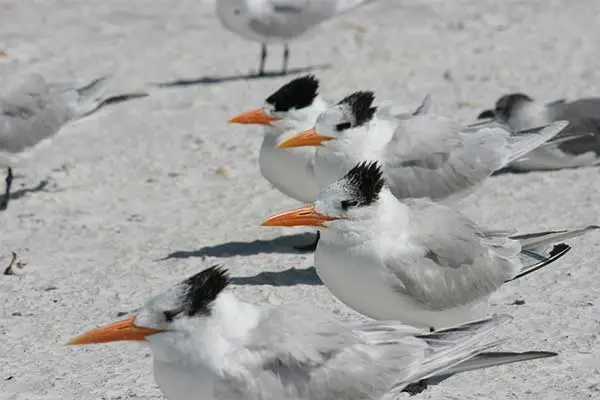
Scientific Name: Thalasseus maximus
Royal terns are the second-largest terns in the world, after Caspian terns. These sleek seabirds are light gray above, white below, and with black caps, black legs, and forked tails.
Royal terns can be also identified by their long, sharp, and bright orange bills.
They are common around the shorelines of Florida and can be seen there during the non-breeding season. Some populations might stay there year-round.
Royal terns have very short clear shrill calls that sound like “kree” or “tsirr“. They are medium-distance migrants and carnivores – royal terns feed on small fish, shrimp, and crustaceans.
A flock of royal terns is known as a “highness”.
Anhinga

Scientific Name: Anhinga anhinga
Anhingas are large waterbirds that are native to Florida where they inhabit lakes, freshwater marshes, ponds, and canals.
They are also known as snakebirds, darters, or water turkeys – they keep their long necks above the water when swimming, making them look like snakes.
Males are black with white spots on their wings and backs; females are similar but have brownish necks and heads. Anhingas have very long and dagger-like orange beaks they use for hunting and spearing fish.
They do not have waterproof wings as other birds do and can be often seen drying their feathers in the sun after getting out of water.
Great Blue Heron

Scientific Name: Ardea herodias
Great blue herons are the largest North American herons and one of Florida’s largest birds.
They are blue-gray, have short black plumes on their heads, and black and chestnut patterns on the shoulders. During the flight, they will hold their necks in an S-shape with legs trailing behind.
Great blue herons have very long beaks that become orange at the start of the breeding season. Their sharp bills are from 4.4 to 7 inches long.
Great blue herons are permanent residents found in wetlands throughout Florida. In south Florida and the Florida Keys, there is an all-white subspecies of great blue herons known as the great white heron.
These birds native to Florida will go through some interesting courtship rituals, locking and rubbing their bills on the feathers of the other bird before mating. Great blue herons are monogamous only for a single season and both parents will take turns in incubating the eggs.
American White Pelican
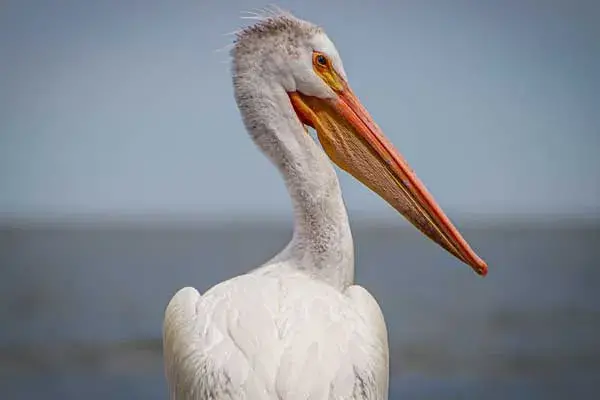
Scientific Name: Pelecanus erythrorhynchos
American white pelicans are the biggest birds in Florida.
Everything about these all-white birds with black flight feathers is enormous. They have a wingspan of up to 9.85 feet and can weigh as much as 30 pounds.
American white pelicans also have the longest beaks of any North American waterbird. Their beaks are vivid orange and measure between 10.3 and 15.2 inches.
The beaks are flat on top and might have “horns” on the upper mandibles. Under the beaks, pelicans have huge throat sacs they use for feeding and filtering food from the water.
American white pelicans migrate to Florida to spend the winter there. They start arriving in the state around September and stay there until March; they move north to breed in the northern part of the Western USA and Canada.
Read More: What are some birds in Florida with the longest beaks?
American Oystercatcher
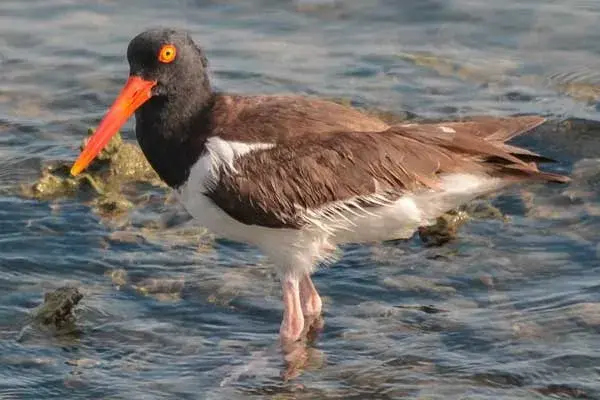
Scientific Name: Haematopus palliatus
American oystercatchers are large shorebirds found on the beaches of the Atlantic and Gulf coasts.
They have black heads and breasts, grayish-brown backs, tails, wings, and white underparts. Their yellow eyes are edged with orange eye-rings.
American oystercatchers have long, bright orange beaks, around 3 inches long. The beaks are razor-sharp and the birds use them to pry open oysters and other bivalves for food, hence the name “oystercatcher”.
Their thick and long beaks have a very strong orange glow that it might seem from distance like the species are eating a carrot!
American oystercatchers are permanent residents of the shores of the Florida Panhandle and breed there from April to July; some populations might migrate to southern parts of the state during winter.
During the breeding season, they inhabit sand or shell beaches, dunes, salt marshes, marsh islands, and mudflats; when the winter comes, they are common around shellfish beaches and mud and salt flats.
Oystercatchers are social birds often seen during the day foraging, preening, resting, and sunbathing.
Mottled Duck

Scientific Name: Anas fulvigula
Mottled ducks are commonly found around freshwater marshes and ponds in central parts of Florida.
Both sexes look similar and resemble female mallards – mottled ducks have overall mottled brown plumage. Males and females look alike and have a shiny green-blue wing patch.
The main difference is the beak; females have deep to pale orange beaks while males have bright yellow ones.
Mottled ducks do not migrate and stay year-round in most of central and southern Florida. One subspecies of mottled ducks, the Florida mottled duck, occurs south of Tampa and has a lighter color and less heavily marked plumage than other subspecies.
Double-crested Cormorant

Scientific Name: Phalacrocorax auritus
Double-crested cormorants are large waterbirds commonly found around the bays, lakes, ponds, canals, and marshes throughout Florida.
They are permanent residents of the state and can be identified by their small heads, long necks, and thin, strongly hooked orange beaks. When the breeding season starts, bushy white eyebrows (feathery tufts) will appear on a male cormorant’s head.
Despite being excellent swimmers and divers, double-crested cormorants do not have fully waterproof feathers and can be seen standing on the shore, with their wings spread to dry.
Great Egret
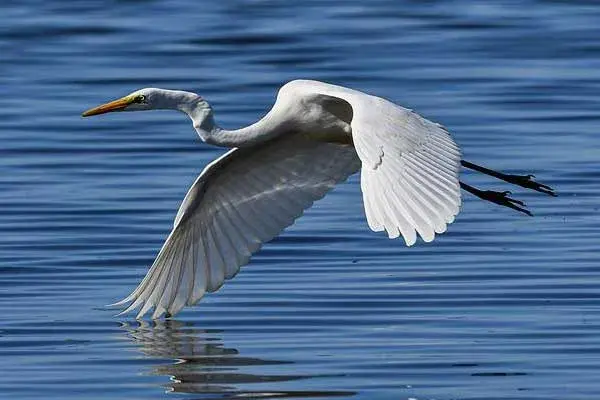
Scientific Name: Ardea alba
Great egrets are impressively large birds with long necks and a wingspan of up to 5 ft 7 in. They have all-white plumage and long black legs.
Great egrets have long yellow-orange beaks that are between 4.2 and 5.3 inches long; they use them for hunting. During the breeding season, their beaks might become darker.
Great egrets are permanent residents of Florida and can be seen there throughout the year, around wetlands and other areas of water. Breeding might happen in any part of the year, but it’s most common from May to August.
Their beautiful plumes called “aigrettes” were used as hat decoration in the 19th century which led to them almost becoming extinct. Thanks to several laws and conservational measures, their numbers have since recovered.
They are seasonally monogamous (stay with the same partner for one breeding season) and display their mating season plumage and colors and point their beaks upward to attract partners.
Great egrets will slowly stalk their prey or stay motionless, waiting for the right moment to strike and impale prey with their long, sharp bills.
Here’s a video of how great egrets hunt; notice their vivid bill color.
Great egret hunting
Mallard
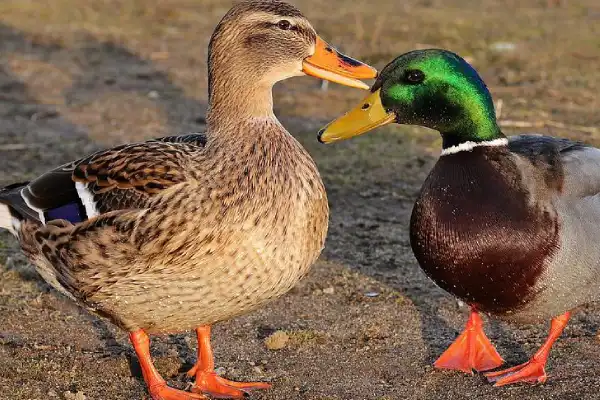
Scientific Name: Anas platyrhynchos
Mallards, also known as wild ducks, are large dabbling ducks found in the Americas, Europe, Asia, and North Africa. They are considered the ancestors of nearly all domestic duck breeds.
Mallards are winter residents of Florida, found anywhere with water, including city parks, backyard creeks, and various wetland habitats.
Identify male mallards by their dark green heads, white collars, and yellowish-green beaks with black tips; females and juveniles have mottled brown plumage and orange bills with brown spots.
A male mallard is called a drake and a female is a hen. These orange-billed ducks fly fast and swim well – they have a 3 ft wide wingspan and can reach a top speed of 70 mph!
Summary
This concludes our list of Florida birds with orange beaks.
Examples include pelicans, oystercatchers, terns, herons, egrets, ducks, and many others.
Next time, when you see these birds in person, you should recognize any of them with ease! And if you enjoyed our article, feel free to read our other popular bird articles.